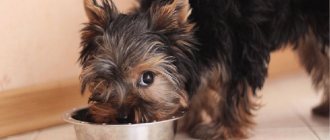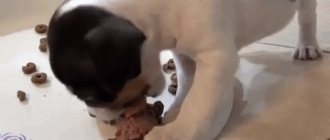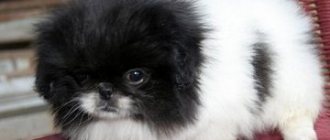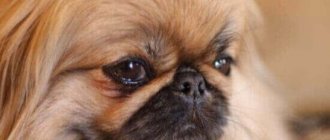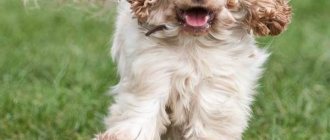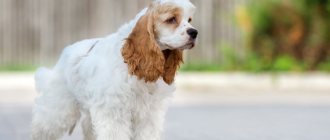The American Cocker Spaniel and its English counterpart are somewhat different in body structure and character traits, but they need the same nutrition and care. Before buying a puppy, the future owner should ask the breeder what to feed the cocker spaniel. It is also useful to learn how to properly organize feeding a Cocker Spaniel puppy. A balanced, high-quality diet will help him remain an energetic, healthy animal for a long time.
Breed Features
The Cocker Spaniel is a medium-sized dog. Active, playful, agile, energetic with well-developed body muscles, she will require careful attention to her diet.
This breed has a good appetite. They are not picky and are easy to please with food. Raised and trained, she will not beg for food, but will always gladly accept it. The dog is very attached to the owner and family. Strangers cannot always communicate friendly with a four-legged animal, but this does not prevent her from taking food from strangers.
Possessing hunter abilities, spaniels can rummage through garbage heaps in search of food.
A distinctive feature of the breed are low-set ears with long hair, which are constantly trying to get into the bowl and get dirty. It is in this matter that you should carefully consider the organization of the feeding area.
Choosing a place and dishes
Before starting to feed cocker spaniels, they undergo a procedure of “covering” their ears. Being long, they “climb” into a bowl of food, or water if it is nearby and cause unnecessary problems in caring for them.
Owners, when solving this problem, go in two ways:
- The hanging ears are tied up (fixed) with a special mesh, wearing it like a collar and tucking the ears;
- Equip a place for receiving food and water, taking into account the peculiarities.
While the puppy is small, there are no special requirements for the feeding area. Over time, when the puppy grows up, the owner begins to solve the problem.
This can be done as follows:
- set up the feeding area on a hill so that the ears “do not drag along the floor”;
- The bowl should not just be placed on a stand, but should be deepened into it so that it does not move from its place. The dishes are selected from food material, durable, heavy;
- The bowl should be deep, but not wide. In this case, when eating food, the ears will hang outside the bowl and not get dirty, and they will also not reach the floor;
- There is no need to place a bowl of water nearby. Otherwise, when the dog eats, even if the ears do not end up in the food bowl, they will “climb” into the water bowl.
All of the above “wisdom” will not help if the dog gets used to taking food out of the bowl and eating where he wants. However, Cocker Spaniels are very trainable.
When adopting a puppy, you need to teach him to eat food from a bowl from the first day; this will make it easier to care for the dog and the food intake area in the future.
The “canteen” for a dog should be:
- with easy to clean surfaces;
- in a place where the dog will not disturb household members;
- in a place easily accessible to the pet.
Advice: For a cocker spaniel, a special requirement will be distance from the place of play. This dog can easily turn over all the bowls, along with the “pedestals”.
Ready-made feed
Granules from a bag are becoming more and more common, and this is understandable. The manufacturer is trying in every possible way to “persuade” the owner that the food has the highest performance, and his puppy will not grow up without granules. Meanwhile, independent laboratory testing constantly proves that the feed does not have the properties and composition specified in the recipe and annotation.
The puppy eats the granules with pleasure. However, the number of flavors and flavoring additives is so great that it cannot be otherwise.
Ready-made food is easy to use. By purchasing a large bag with a long shelf life, you can feed your puppy without any problems. There is no need to even wash dishes. Only the question of the dog's health remains open.
Ready-made foods are derivatives with the addition of artificial protein. High temperatures in the extruder kill all biologically active substances and vitamins. When feeding ready-made food, you need to be careful about the puppy’s water balance. The manufacturer warns on the package that there must be water in the drinking bowl at all times, since the feed causes thirst.
Advantages
The food has a number of advantages:
- with its help you can feed the puppy quickly;
- clean dishes will remain after the meal;
- feed is easy to buy and store.
Flaws
When feeding with prepared foods:
- inability to control the composition independently;
- in a coma there may be allergens that are difficult to identify;
- non-compliance of the formulation with the results of laboratory tests (even for expensive samples) casts doubt on its usefulness.
If these arguments are not arguments, then when choosing food you should at least ask:
- labeling (manufacturer, address, telephone);
- date of manufacture;
- deadline for implementation;
- read the manufacturer's recommendations.
Mixed diet
This is the type of feeding that many owners prefer. Natural food is fed constantly, and when necessary, ready-made food is fed. Ready-made food is used for:
- travel;
- inability to purchase food;
- Difficulties with preparing food.
Whatever diet the owner chooses, it is necessary to monitor the state of the gastrointestinal tract. At the slightest “failures,” you should reconsider the feeding program and seek help from a specialist.
Natural diet
The Cocker Spaniel, like any dog, is a predatory, carnivorous animal. Its diet differs from the human diet, since the owner of the animal is an omnivore. What a person considers extremely healthy (fruits, vegetables, cereals, grains) is not considered healthy for a dog.
Your dog's daily diet should contain:
• meat (trimmings, offal, bones); • fish (except for fish from inland waters); • dairy products (except those labeled “milk-containing” or “milk product”); • eggs.
Advantages
Feeding with natural products is natural feeding. With it you can:
- satisfy the body with all necessary substances;
- in case of problems, it is easy to detect the intolerable ingredient and remove it from the diet;
- control nutrients and feed quality;
- it does not contain artificial additives, preservatives or emulsifiers.
Sample menu by age
Up to a month
The puppy needs mother's milk. It, unlike cow's milk, is fattier, has more phosphorus, sugar and protein. However, the main thing is that it is a source of immunity. If the puppy is left without a mother, it is better to find a wet nurse. If this is not possible, then you should:
- use milk substitutes;
- infant formulas (they are enriched with phosphorus and have calcium removed);
- prepare food yourself.
Milk replacers should be purchased at a pet store and prepared according to the instructions.
If this is not possible, then chicken egg yolk and sugar are added to cow's milk. The puppy is fed 10-12 times a day, 20-30 g each. A hungry puppy will make sounds and be in search of food.
Natural food
Natural nutrition for cockers should be comprehensive. It is recommended to feed them meat, fish, fermented milk, cereals, vegetables and fruits. It is necessary to balance the dog’s diet as much as possible:
- Meat should form the basis of natural food and account for two-thirds of the volume. Boiled chicken or beef will do. An adult dog can eat up to 300 g of meat with cartilage and tendons per day. If meat is replaced by offal, the feed portion size increases by 30%. It is not recommended to feed a cocker only meat.
- Sea fish is a source of phosphorus and omega 3 fatty acids. It is necessary to feed your American Cocker Spaniel this product 2 times a week.
- Fermented milk products and eggs are a source of animal protein for a growing body. This food is very useful.
- Vegetables and fruits , cereal products and bread should make up a third of the diet. Carrots, pumpkin, zucchini, cucumbers are given raw, with vegetable oil or heat-treated.
- It is useful to cook porridge in water or milk from rice, buckwheat, or oatmeal.
- Apples, pears, and bananas are suitable fruits , but not oranges.
Fish oil is offered as a dietary supplement. In the first days, the optimal dosage is 2-3 drops. Gradually increase the amount to 2 teaspoons if there are no side effects.
Vitamins and supplements
If the diet is balanced and contains all food groups, then there is no need for vitamins and supplements.
Synthetic vitamin preparations are medicines. Their appointment is associated with certain diseases, the diagnosis of which is established after a comprehensive examination.
If the puppy has:
- good wool;
- clean skin;
- mucous membranes are not anemic;
- He is active and playful, there is no point in giving him vitamins. In case of problems, you should consult a doctor.
Water
Drinking, clean water must be available at all times. Thirst without drinking water, even short-term, leads to metabolic disorders.
Particular attention is paid to water when:
- feeding with prepared food;
- high physical activity.
You need to monitor your water consumption. Drinking too little or too much water is not a disease, but may be a sign of certain metabolic disorders. In this case, you should consult a doctor.
How many times a day should you feed your English Cocker Spaniel?
A puppy is fed more often than an adult dog. The number of feedings depends on the age of the puppy.
| Age of English Cocker Spaniel | Number of feedings per day | Amount of food (with natural feeding) |
| 2 – 4 months | 5 | Up to 2 tablespoons per feeding |
| 4 – 6 months | 4 | 4 - 5 tablespoons per feeding |
| 6 – 12 months | 3 | Depending on the dog's body condition and activity level |
| Over 12 months | 2 |
Prohibited Products
Food and dog food are completely different. Even if the pet loves it and begs for a “treat,” this cannot be abused.
A dog, especially a puppy, should not be fed:
- sausage, frankfurters and smoked meats;
- raw offal, chicken and fish;
- sauces;
- fried meat and fish products;
- fat meat;
- flour and confectionery products (including pasta).
The puppy's appetite is influenced by the composition of the diet and temperament, physical activity and weather conditions. Observing the dog and analyzing what it eats can tell you where to adjust the diet in order to prevent unwanted situations.
What not to feed your pet
If you intend to feed your English Spaniel "in English", do not forget to pay attention to the list of prohibited foods that are contraindicated or not allowed for your puppy.
- Avoid hot food that has just been cooked on the stove. The pet can get burned by it;
- Do not use food from the refrigerator. Before giving it to the puppy, bring it to a warm state;
- Avoid spicy, salty, fatty and sweet foods;
- You should also not pamper your pet with smoked food or river fish. Instead, he can be given boiled seafood. Freshwater and raw seawater are prohibited, because they can cause worms;
- Never give your puppy bones in any form. And although many are of the opinion that bones are a necessary part of the diet, do not make this mistake. They can cause the death of your pet and often cause constipation, intestinal perforation and volvulus. Particularly dangerous are tubular bones that can splinter into sharp pieces.
- Do not feed your pet pasta, legumes, white bread and potatoes;
- Do not give your dog sausages, salami or smoked meats. Sausages are real poison for spaniels.
By following these simple recommendations and rules, you can raise a healthy and beautiful pet.



